Av Retamayoc L-10, San Sebastián 08002
- +51 940 809 144
- Travel Blog
- About Us
- Contact Us
Av Retamayoc L-10, San Sebastián 08002
Chat to a Andean Road Peru
If you're looking for a unique experience during your trip to Peru, Tambomachay is a must-visit destination. Known as the "Water Temple", this archaeological site is one of the most impressive remnants of the Inca Empire. Located just 7 kilometers from Cusco and surrounded by the breathtaking Andes mountains, Tambomachay offers a fascinating glimpse into Inca engineering, featuring an advanced hydraulic system that still functions today. Visiting this site not only immerses you in the history of one of the greatest ancient civilizations. It also allows a connection with the spirituality and reverence the Incas had for nature, especially water, which was sacred.
Also, you may be interested in reading: Visiting Pisac ruins: A Journey through history and culture
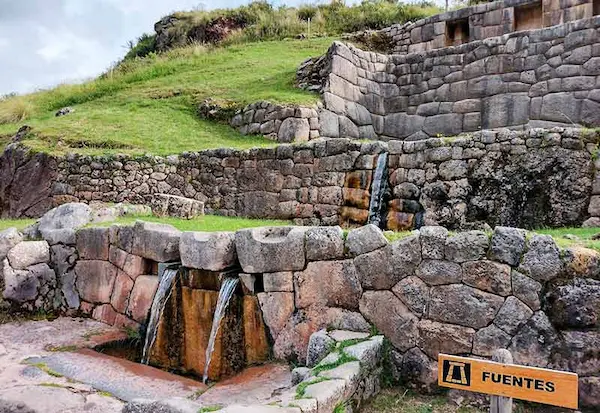
One of the most remarkable features of Tambomachay is its sophisticated hydraulic system. Unlike many ancient sites where the water systems have either deteriorated or are no longer functioning, Tambomachay’s aqueducts, fountains, and channels continue to operate with precision, some 500 years after the fall of the Inca Empire. This functional water management system is a testament to the advanced engineering skills of the Incas.
The site’s water system includes carefully constructed channels and terraces that allow water to flow seamlessly through various fountains, creating a visual spectacle of cascading water. Even after centuries of abandonment, the water flows naturally, a remarkable feat that still baffles engineers and archaeologists alike. The Incas used their extensive knowledge of hydrology to channel spring water with remarkable accuracy across the site. These water features were both functional and symbolic, representing the Incas' reverence for water as a vital, life-giving force.
Interestingly, these fountains were not merely decorative; they played a vital role in religious and ceremonial practices. For the Incas, water was sacred, symbolizing life, fertility, and the masculine principle in contrast to Pachamama, the feminine earth goddess. In Inca cosmology, water was associated with the cosmic balance and the relationship between the earth and the heavens. The careful design of the hydraulic system at Tambomachay reflects the Incas' understanding of water as both a vital resource and a divine element.
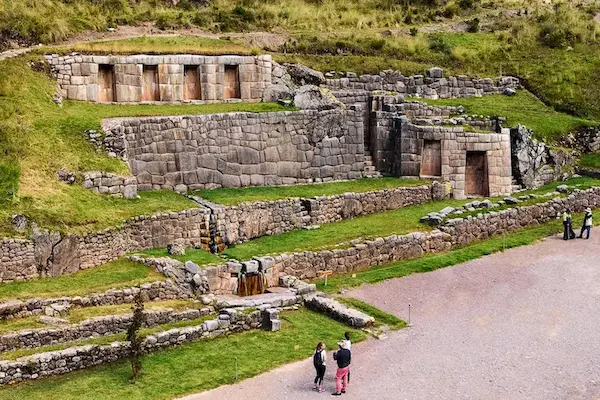
Tambomachay's location is one of its most captivating features. Positioned in a remote valley surrounded by towering mountains, the site offers a unique blend of natural beauty and architectural grandeur. The complex’s elevation at 3,700 meters above sea level places it high within the Andean mountain range, providing panoramic views of the surrounding landscape.
The serene atmosphere of Tambomachay likely made it a retreat for Inca royalty. Surrounded by diverse Andean flora, it served as a peaceful sanctuary. The nearby mountains, including the majestic peaks of Salkantay and Veronica, enhanced the site’s spiritual ambiance and tranquil environment.
Tambomachay was strategically located for accessibility, close enough to Cusco, the heart of the Inca Empire, yet secluded enough to provide a tranquil setting for religious and ceremonial practices. This combination of natural beauty and functional design underscores the importance of the site within the Inca religious and cultural framework.
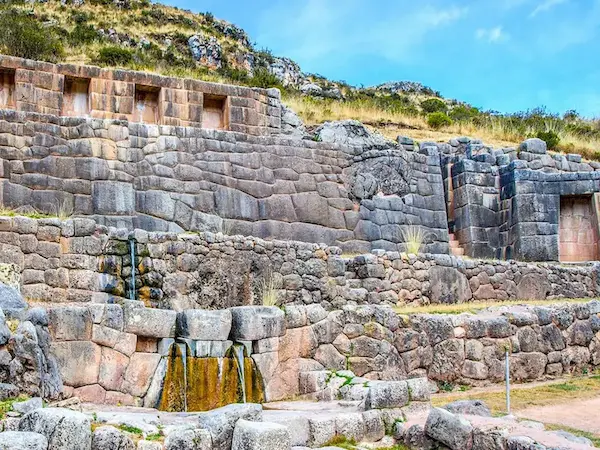
Water held great significance in Inca culture, not only as a physical necessity but also as a powerful symbol of fertility and life. The Incas believed that water was essential for maintaining the fertility of the land and the prosperity of their empire. In their worldview, water represented the masculine principle, while the earth, Pachamama, symbolized the feminine. The harmonious interaction between water and earth symbolized the key to agricultural fertility and the thriving of all life.
At Tambomachay, the water system served as a physical manifestation of this cosmic balance. The site is believed to have hosted rituals for water and fertility, with water flowing as an offering to Pachamama. This practice aligns with Inca beliefs that reverence for nature was crucial for the empire’s prosperity. The continual flow of water symbolized their respect for nature’s sustaining elements.
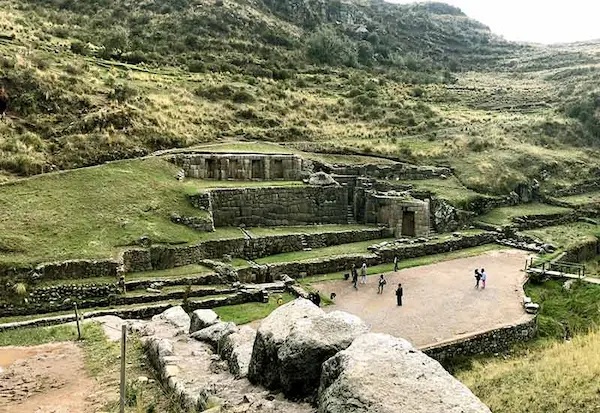
Today, Tambomachay remains an awe-inspiring site for visitors seeking to understand the complexity and grandeur of Inca civilization. As tourists explore, they immediately notice the arrangement of the four main terraces dominating the landscape. These terraces, expertly constructed with finely cut stones, served both practical and ceremonial purposes. The trapezoidal niches at the top of the terraces, reaching two meters, may have served for ceremonial offerings or defense.
The meticulously built aqueducts and channels are particularly impressive, as they demonstrate the skill with which the Incas managed water.The continuous flow of water through the stone channels offers a direct link to the past and showcases the Inca Empire's advanced hydraulic engineering.
Exploring the site also provides visitors with the opportunity to appreciate the natural beauty that surrounds it. Tambomachay is located near other important archaeological sites such as Puca Pucará, a military outpost, and Qenqo, a ceremonial site associated with Inca religious practices. These neighboring sites provide visitors with a comprehensive understanding of the Inca Empire’s complexity, from military strategy to religious rituals.
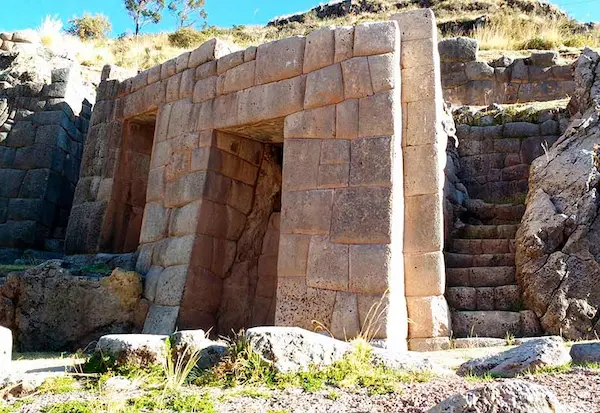
Tambomachay’s legacy lies not only in its hydraulic system but also in its reflection of Inca ingenuity and reverence for nature. The site demonstrates the Incas' skill in merging engineering with deep religious beliefs, a hallmark of their empire. Additionally, Tambomachay is part of the famous Inca Trail, which connects several important archaeological sites in the Cusco region, including Machu Picchu. This historic trail allows travelers to experience the landscape and culture of the ancient Incas up close.
The site also offers a glimpse into the daily life of the Inca elite. While Tambomachay primarily functioned ceremonially, it also provided a place of rest for Inca rulers, including the revered Tupac Yupanqui, who used the site for spiritual reflection. The connection to both the sacred and royal aspects of Inca society makes it a valuable source of insight into the life and beliefs of the empire.
Tambomachay is a key site for understanding the technological prowess of the Incas. The advanced hydraulic systems still functioning today showcase the empire's expertise in water management and engineering. It symbolizes the Incas' harmonious relationship with nature, demonstrating their adaptability in a challenging geographical setting.
Visiting Tambomachay is an opportunity to dive into the heart of Inca culture, where history, engineering, and nature come together in perfect harmony. Whether you're a history enthusiast, an archaeology lover, or simply someone who enjoys stunning landscapes, this site will not only astonish you but also help you understand the profound connection the Incas had with their environment. As you explore Tambomachay, you’re not just discovering an ancient monument; you're experiencing a key part of the identity of the Andes and its people. Don’t miss the chance to uncover one of Peru's best-kept secrets, a place that continues to bear witness to the legacy and wisdom of a civilization that left an indelible mark on world history.
Tambomachay is an important archaeological site of the Inca Empire, located near Cusco, known for its sophisticated hydraulic system and its connection to Inca water-related rituals.
Tambomachay is often referred to as the "Water Temple" because of its complex network of aqueducts, fountains, and channels that demonstrate the Incas' advanced understanding of water management. Water was sacred in Inca culture, symbolizing life and fertility, and was central to the rituals performed at the site.
Tambomachay is situated 7 kilometers from the city of Cusco, Peru, at an altitude of 3,700 meters above sea level, nestled in the Andean mountains.
Water was considered sacred by the Incas and symbolized life, fertility, and the masculine principle. At Tambomachay, the flowing water was central to rituals that honored the natural elements and the fertility of the land. It was a vital element in Inca ceremonies, reflecting the harmony between water (the masculine) and Pachamama (the earth, the feminine).
Yes, the hydraulic system at Tambomachay is still functional today, with water flowing continuously through its ancient channels, a testament to the advanced engineering skills of the Incas.
Leave a comment